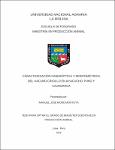Mostrar el registro sencillo del ítem
Caracterización faneróptica y morfométrica del vacuno criollo en Ayacucho, Puno y Cajamarca
| dc.contributor.advisor | Barrón López, José Alberto | |
| dc.contributor.author | More Montoya, Manuel José | |
| dc.date.accessioned | 2017-09-27T18:14:49Z | |
| dc.date.available | 2017-09-27T18:14:49Z | |
| dc.date.issued | 2016 | |
| dc.identifier.other | L01.M674-T BAN UNALM | |
| dc.identifier.uri | https://hdl.handle.net/20.500.12996/2747 | |
| dc.description | Universidad Nacional Agraria La Molina. Escuela de Posgrado. Maestría en Producción Animal | es_PE |
| dc.description.abstract | El objetivo de la presente investigación fue evaluar las características fanerópticas y morfométricas del ganado vacuno criollo peruano en Ayacucho, Puno y Cajamarca; abarcando características del pelaje, medidas e índices biométricos. Los datos fueron tomados de 421 animales (194 machos y 227 hembras), con cuatro o más dientes permanentes. Las características fanerópticas (patrón de coloración, denominación de pelaje y color primario), se evaluaron mediante observación y registro fotográfico. Las características biométricas se evaluaron en dos regiones (Ayacucho y Puno). Las características fanerópticas fueron analizadas mediante tabulaciones de frecuencias y comparación de proporciones. El análisis de las medidas biométricas comprendió el cálculo de estadísticos de tendencia central y de dispersión; la comparación entre regiones mediante un Diseño Completamente al Azar; la evaluación del efecto del sexo y la edad mediante un arreglo factorial (2x3); y la evaluación de las asociaciones aplicando la correlación de Pearson. Los resultados indican una mayor incidencia de pelaje negro y patrón simple (92,5 y 83,6; 62,8 y 42; 47,1 y 38,8 por ciento en Puno, Cajamarca y Ayacucho, respectivamente). Los criollos puneños presentaron un mayor desarrollo corporal que los ayacuchanos (124,89 ± 0,59 cm vs. 113,53 ± 1,15 cm de altura a la cruz; 169,55 ± 1,44 cm vs. 157,09 ± 1,03 cm de perímetro torácico; 146,20 ± 2,46 cm vs. 127,56 ± 1,51 cm de longitud corporal, respectivamente). Los índices biométricos del criollo ayacuchano no corresponden a una orientación lechera o cárnica (índices dáctilo torácico de 10,42 ± 0,08 y corporal lateral de 89,13 ± 1,02); mientras que la fineza del esqueleto de los criollos puneños muestra una orientación lechera (índice dáctilo torácico de 9,89 ± 0,08). Los vacunos criollos muestran diferencias en sus características fanerópticas y morfométricas según la región evaluada, lo cual debería ser considerado en programas de mejoramiento genético. | es_PE |
| dc.description.abstract | The aim of this research was to evaluate the phaneroptic and morphometric traits of the peruvian creole cattle in Ayacucho, Puno and Cajamarca; including coat traits, biometric measures and indexes. The data was collected from 421 cattles (194 males and 227 females) with four or more permanent teeth. The phaneroptic traits (color pattern, coat denomination and primary color) were evaluated by observation and photographic record. The biometric traits were evaluated in two regions (Ayacucho y Puno). The phaneroptic traits were analyzed by frequency tabulations and comparison of proportions. The analysis of the biometric measures included the estimation of central tendency and dispersion, a completely ramdomized design was used to compare the differences between regions, a factorial arrangement (2x3) was used to evaluate the effect of the sex and the age, and pearson correlation was used to evaluate the associations amount the traits. The results indicate higher incidence of black coat and simple pattern (92,5 and 83,6; 62,8 and 42; 47,1 and 38,8 percentage in Puno, Cajamarca, Ayacucho, respectively). The creoles in Puno had more body development than the creoles in Ayacucho (124,89 ± 0,59 cm vs. 113,53 ± 1,15 cm of height at withers; 169,55 ± 1,44 cm vs. 157,09 ± 1,03 cm of toracic perimeter; 146,20 ± 2,46 cm vs. 127,56 ± 1,51 cm of body length, respectively). The biometric indexes of creole of Ayacucho do not correspond to a dairy or beef orientation (dactylo-thoracic index of 10,42 ± 0,08 and body side index of 89,13 ± 1,02); while the fineness of the skeleton of the creole of Puno show a milk orientation (dactyle-thoracic index of 9,89 ± 0,08). The creole bovines show differences in their phaneroptic and morphometric traits according to the region; which they should be considered in breeding programs. | en_US |
| dc.description.uri | Tesis | es_PE |
| dc.format | application/pdf | en_US |
| dc.language.iso | spa | es_PE |
| dc.publisher | Universidad Nacional Agraria La Molina | es_PE |
| dc.rights | info:eu-repo/semantics/openAccess | en_US |
| dc.rights.uri | https://creativecommons.org/licenses/by-nc-nd/4.0/ | * |
| dc.source | Universidad Nacional Agraria La Molina | es_PE |
| dc.source | Repositorio institucional - UNALM | es_PE |
| dc.subject | Ganado bovino | es_PE |
| dc.subject | Razas (Animal) | es_PE |
| dc.subject | Anatomía animal | es_PE |
| dc.subject | Conformación animal | es_PE |
| dc.subject | Biometría | es_PE |
| dc.subject | Recursos genéticos animales | es_PE |
| dc.subject | Pelo | es_PE |
| dc.subject | Evaluación | es_PE |
| dc.subject | Piel (Animal) | es_PE |
| dc.subject | Perú | es_PE |
| dc.subject | Ganado criollo | es_PE |
| dc.subject | Características Faneropticas | es_PE |
| dc.subject | Características Morfometricas | es_PE |
| dc.subject | Ayacucho (Dpto) | es_PE |
| dc.subject | Puno (Dpto) | es_PE |
| dc.subject | Cajamarca (Dpto) | es_PE |
| dc.title | Caracterización faneróptica y morfométrica del vacuno criollo en Ayacucho, Puno y Cajamarca | es_PE |
| dc.type | info:eu-repo/semantics/masterThesis | en_US |
| thesis.degree.discipline | Producción Animal | es_PE |
| thesis.degree.grantor | Universidad Nacional Agraria La Molina. Escuela de Posgrado | es_PE |
| thesis.degree.name | Magister Scientiae - Producción Animal | es_PE |
| thesis.degree.level | Maestría | es_PE |
| dc.subject.ocde | https://purl.org/pe-repo/ocde/ford#4.02.02 | es_PE |
Ficheros en el ítem
Este ítem aparece en la(s) siguiente(s) colección(ones)
-
M-PAN Tesis [97]



